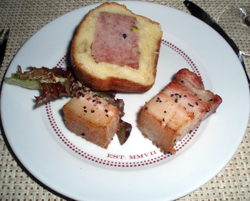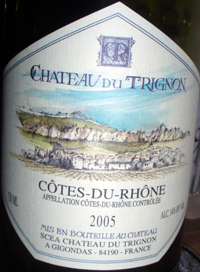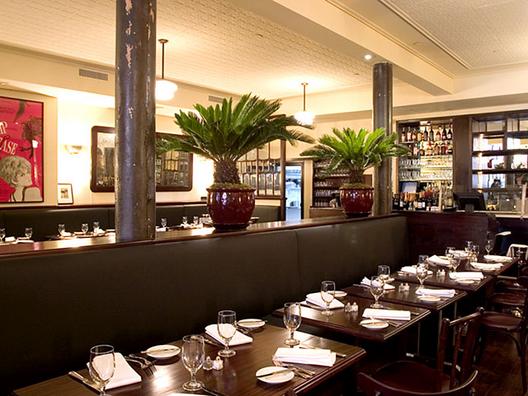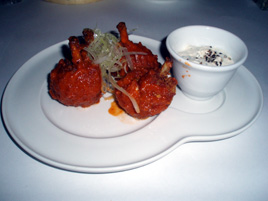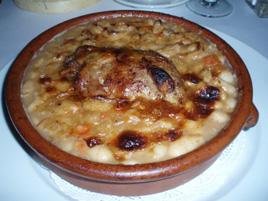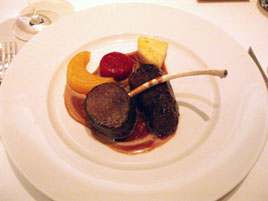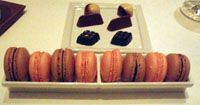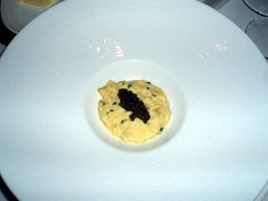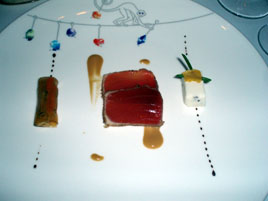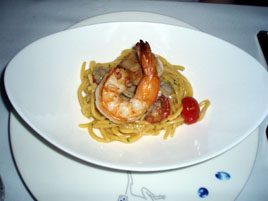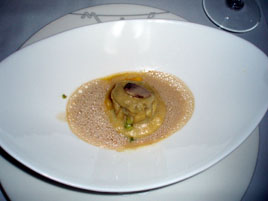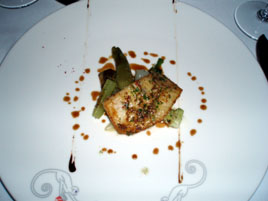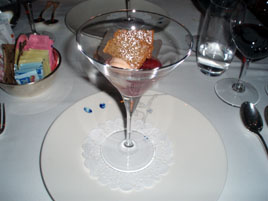

Left: The walk-thru wine cellar; Right: The dining room
Note: Bruni Jamais has closed.
*
Five years ago, Bruno Jamais opened his “exclusive” restaurant club on the Upper East Side. The Times reported that admission was open only to Mr. Jamais’ exclusive client list, honed over his years as maître d’hôtel at Daniel and Alain Ducasse. Membership in the club was $7,000 a pop.
 The restaurant is on a quiet Upper East Side block in an elegant townhouse, just steps away from the Metropolitan Museum of Art. Starchitect Tony Chi’s interior, featuring a spectacular walk-through wine cellar, won Hospitality Design’s Best Restaurant Design award in 2004. The dining room now doubles as a one-man show for the French artist Cyrille Margarit. Even Donald Trump might find it too opulent.
The restaurant is on a quiet Upper East Side block in an elegant townhouse, just steps away from the Metropolitan Museum of Art. Starchitect Tony Chi’s interior, featuring a spectacular walk-through wine cellar, won Hospitality Design’s Best Restaurant Design award in 2004. The dining room now doubles as a one-man show for the French artist Cyrille Margarit. Even Donald Trump might find it too opulent.
Critics mostly ignored the restaurant, which was evidently as Mr. Jamais wanted it. The only pro review was in the New Yorker, which found the food mediocre. The critic was more intrigued by diners whose dates seemed to be paid by the hour.
The supper club idea didn’t last; these days, anyone can get in. Indeed, there’s a distinct sense of almost begging, with the menu reminding you—in capital letters, no less—that the space is available for “BIRTHDAY PARTIES, SPECIAL OCCASIONS, WEDDING RECEPTIONS & CORPORATE EVENTS.” Thursdays, Fridays and Saturdays are singles’ nights, and there’s a half-price prix fixe on Sundays.
There’s a decent number of reviews on the web, though some of the writers may be shills. The food seems to have been uneven over the years—sometimes terrific, but not dependable. The revolving door in the kitchen cannot have helped: the restaurant opened in late 2002, and it’s already on its fourth chef.

With that background, this isn’t a restaurant I would have chosen without an invitation. Full disclosure: our food and drinks were on the house, though I paid for the wine myself. Having said that, we were extremely impressed. The cuisine at Bruno Jamais is serious and excellent.
John Keller, who previously worked at Le Bernardin and Nobu, has been executive chef since 2006. His deft menu, which changes daily, is mostly conservative, but Keller can be clever too. Ingredients like caviar and foie gras are deployed liberally, but not in the lazy ways of chefs who use luxury as a substitute for thought. This is cooking of a high order.
The wine list is impressive, with one of the city’s better selections of Bordeaux and Burgundies. It skews expensive, but there are bottles as low as $40 (not many, though). A 1993 Chateau Lynch-Moussac Pauillac seemed to me fairly priced at $140.
There are some good house cocktails, too, but I failed to note all the ingredients in the one I liked best—something called “Sexy Back,” which the bartender recommended. The house signature cocktail, the Bruno’s Martini Platinum, was decent but crazily over-priced at $38.
The early New Yorker review complained of stratospheric prices: in 2002, a $42 entrée was sufficient to provoke outrage. Today, it’s at the high end of mainstream. Appetizers are $12–25, main courses $22–42 (most in the low thirties), side dishes $7–10. While clearly not inexpensive, there are plenty of Manhattan restaurants at this price level, including many that aren’t nearly as good.
The menu is reasonably focused, too, with just ten appetizers and ten entrées. There are a few nods to Asia and a number of French classics, but the menu is written in English. Portion sizes are ample.



Toast points with tomato chutney (left); Bread service (center); Goat cheese and mushroom strudel (right)
The bread service began with warm toast points and a tomato chutney spread. There was also a basket of excellent fresh breads, which cold triangles of butter didn’t live up to. The amuse-bouche continued the tomato chutney theme, with a terrific goat cheese and wild mushroom strudel.


Lobster Brûlee (left); Foie Gras Terrine (right)
Lobster Brûlée ($25) was an absolute knockout—think crème brûlée, but with lobster. This is one of the cleverest items on the menu A foie gras terrine ($25) was one of the menu’s more conservative choices, which the kitchen executed well.


Filet mignon au poivre (left); Duck Breast (right)
Steak in a non-steakhouse is often disappointing, but my girlfriend’s Filet Mignon au poivre ($35)—a boring choice, I know—was excellent. Duck breast was just about perfect, served with champagne-vanilla poached pear, chanterelle mushrooms and foie gras. It’s as good as any duck entrée in town, and at $26 you would have to consider it a bargain.




Left to right: Creamed spinach; Truffle mashed potatoes; Potato croquettes with gruyère cream; French fries
The four side dishes that we tried were far more than we needed, but they were all first-rate. The next morning my girlfriend said, “I’m still dreaming about those french fries.”



Homemade cookies (left); Floating island (center); Chocolate soufflé (right)
Our desserts were French standards, executed as well as they are anywhere.
We were seated at a comfortable banquette. The tables are a variety of sizes: ours would have comfortably accommodated four, but others looked seemed awfully small even for two. Service was polished and enthusiastic. Servers’ menu recommendations were sensible and accurate.
The publicist said that Bruno Jamais attracts a late-night crowd (the kitchen takes orders until 3:00 a.m.). She recommended an 8:30 p.m. reservation—later than I normally prefer—so that we could get a better feel for the ambiance. Yet, over the course of three hours, the space was never more than half full. For much of the time, the staff outnumbered the customers. It was a varied clientele, both young and old, not fitting the stereotypes normally attached to such a place.
Does Bruno Jamais want to be taken seriously as a restaurant? If the rest of the food is as good as we had, it certainly should be. It could start by upgrading its website. Even fifteen years ago, it would have looked tacky; today, it is an embarrassment. Memo to Mr. Jamais: the only places that call themselves “ultra elegant” are the ones that are not.
Bruno Jamais—the restaurant, not the man (whom we did not meet)—seemed schizophrenic to us. The supper-club vibe leads you to expect cruise ship cuisine for aging plutocrats, courtesans, and B-list celebrities. Some of the literature still has the quirky, off-putting name, “Bruno Jamais Restaurant Club.” But the kitchen turns out three-star food: there wasn’t a single dud, or anything remotely close to it, among the many things we tried. (Dining on a publicist’s dime, I’ve learned, is no guarantee of excellence.)
We had a wonderful meal, which we did not expect at all. If you pocket your aversion to the faux exclusivity that Bruno Jamais wears on its sleeve, you’ll find that the food is worth your attention.
Bruno Jamais (24 E. 81st Street between Madison & Fifth Avenues, Upper East Side)
 Wednesday, April 9, 2008 at 01:25PM
Wednesday, April 9, 2008 at 01:25PM 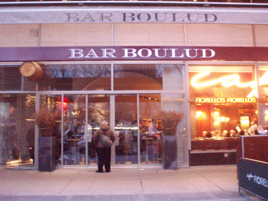

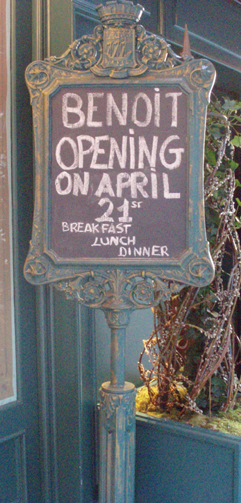 What’s notable is not merely that these restaurants have a nod to the French tradition, but that many of them are overtly traditional, serving the old standards (lobster thermidor, cassoulet, duck à l’orange) that were considered dinosaurs a short while ago.
What’s notable is not merely that these restaurants have a nod to the French tradition, but that many of them are overtly traditional, serving the old standards (lobster thermidor, cassoulet, duck à l’orange) that were considered dinosaurs a short while ago.







